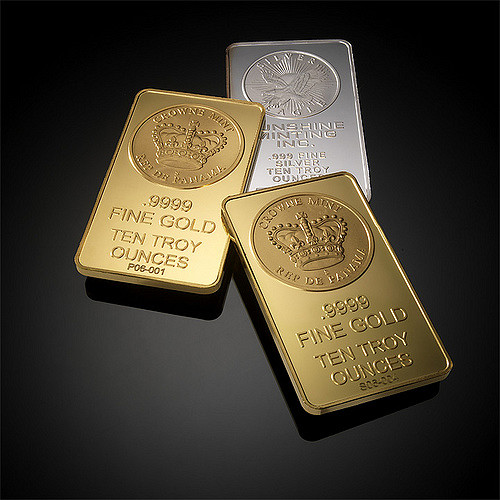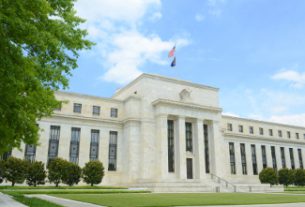In investment circles it’s common to hear that stocks and gold are negatively correlated. That is to say, gold’s price increases when stock prices decrease, and vice versa. That’s why you’ll often hear the recommendation to sell stocks and invest in gold when stocks are doing poorly, and to sell gold and buy stocks when stock markets are doing well. But is it really true that the two are negatively correlated? And if so, is it really a good idea to sell one and buy the other depending on market conditions?
Correlation: Is It There?
Let’s look at a representative sample of gold and stock prices from 2006 to 2015, a time in which stocks peaked, dropped, then peaked again. Gold had already begun to rise in price by 2006, peaked in 2011, then dropped back in price again. If there were a correlation, one would expect to see that in the data. The closer to 1 the correlation coefficient is, the closer the two are correlated; the closer to -1 the correlation coefficient is, the closer the two are negatively correlated.
With over 2200 data points between August 2006 and August 2015, the correlation coefficient is 0.227. That basically means that there’s no correlation whatsoever, either positive or negative, between gold prices and stock prices. But what that means is that an increase in stock prices doesn’t mean that gold prices will go down, nor will a decrease in stock prices automatically mean an increase in the price of gold.
Stock Performance vs. Gold Performance
Well, if there’s no correlation, you might think that there’s no relationship whatsoever. But is that true? Let’s look at what happens to gold when stocks are doing well, what happens to gold when stocks are doing poorly, and what happens to stocks when gold is doing well.
Let’s first look at the three years before the peak of the dotcom bubble. And we’ll look at end of month prices since that’s when many people invest through their 401(k) plans or invest elsewhere after getting paid. From August 1998 to August 2001 the Dow Jones rose at an annualized average of about 14.2%. Gold, on the other hand, was nearly flat, at 0.2%. Over the next two years, as the Dow lost nearly 8% per year on average, gold rose at an annualized rate of 16%.
But stock markets recovered after the bubble burst, and by their near-peak in 2007 had gained again at an average annualized rate of nearly 9%. Gold, however, had once again increased, at a 15.9% annualized rate, thus besting stocks even at a time when stocks were doing really well. When the financial crisis hit, stocks plummeted at an annualized rate of 16% over the next two years, versus gold’s 18.8% annual increase.
Stocks began to recover after that, seeing annualized increases of 11.8% through August 2013, versus gold’s annualized increases of 10.4%. Since then stocks have seen 10.8% annualized increases, versus 2.6% annualized decreases for gold.
Now let’s look at stock performance when gold does well. From 1998 to 2008, just before the financial crisis hit its hardest, gold went on a great run, averaging annualized gains of 11.3%, while stocks only average 4.3% annualized gains. From that point on until August 2011, gold gained at an average annualized rate of 31.4%, versus stocks which were nearly flat at 0.28%.
But gold peaked in 2011 and declined at almost an 11.5% rate over the next three years, while stocks grew at 13.7%. The next year and a half wasn’t great for stocks or gold, with gold declining 1.1% annually and stocks 1.6%. But then stock markets really went on a tear, gaining 18% annually versus 0.1% for gold.
Gold Still Outperforms Stocks Over the Long Run
So while there is no correlation either positive or negative when you compare the data over the long term, you can still see that gold in general tends to perform well when stocks aren’t performing well or are losing money, while when stocks are performing well gold generally tends to perform less well. But both can grow at the same time, and that’s what has happened over a number of periods of time.
The next question most investors want to know is whether they should sell stocks and buy gold when stocks start to dip, and sell the gold to buy back into stocks once a recovery begins. Investors who had moved 30% of their portfolio into gold when stocks peaked in October 2007 still would have seen their portfolios lose value, but because of gold’s outstanding performance during the financial crisis their portfolios would have been nearly 60% more valuable at the worst part of the financial crisis than those who stayed 100% in stocks. And even had they not sold any of their gold since the financial crisis, their portfolios still would have been more valuable than a 100% stock portfolio until just a couple of months ago.
Of course, for investors who want to buy an asset and stick with it, gold has been an outstanding asset over the past several decades, even better than stocks. Gold has seen annualized increases of 7.6% over the past 20 years, versus just 5.2% for the Dow Jones. And since the beginning of the 21st century gold has seen annualized increases of 9%, versus 5% for the Dow Jones and 4.5% for the S&P 500. That’s the power that gold has over the long term, both to protect assets and to offer portfolio growth, which is why so many investors choose to invest in gold both to safeguard their retirement assets as well as to continue growing their portfolios into retirement.
This article was originally posted on Goldco.




